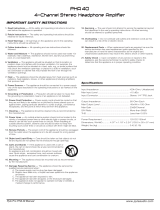
IMPORTANT SAFETY INSTRUCTIONS
1. Read Instructions — All the safety and operating instructions should
be read before the appliance is operated.
2. Retain Instructions — The safety and operating instructions should
be retained for future reference.
3. Heed Warnings — All warnings on the appliance and in the opera-
ting instructions should be adhered to.
4. Follow Instructions — All operang and use instructions should be
followed.
5. Water and Moisture — The appliance should not be used near water -
for example, near a bathtub, washbowl, kitchen sink, laundry tub,
swimming pool, or a wet basement.
6. Ventilation — The appliance should be situated so that its location
or position does not interfere with its proper ventilation. For example,
the appliance should not be situated on a bed, sofa, rug, or similar
surface that may block the ventilation openings: or placed in a built-
in installation, such as a bookcase or cabinet that may impede the flow
of air through the ventilation openings.
7. Heat — The appliance should be situated away from heat sources
such as radiators, heat registers, stoves, or other appliances
(including amplifiers) that produce heat.
8. Power Sources — The appliance should be connected to a power
supply only of the type described in the operating instructions or
as marked on the appliance.
9. Grounding or Polarization — Precaution should be taken to insure
that the grounding or polarization means of an appliance is not defeated.
10. Power-Cord Protection — Power supply cords should be routed
so that they are not likely to be walked on or pinched by items placed
upon or against them, paying particular attention to cords at plugs,
convenience receptacles, and the point at which they exit from the
appliance.
11. Cleaning — The appliance should be cleaned only as recommended
by the manufacturer.
1
12. Power Lines — An outside antenna system should not be located in
the vicinity of overhead power lines or other electric light or power
circuits, or where it can fall into such power lines or circuits. When
installing an outside antenna system, extreme care should be taken
to keep from touching such power lines or circuits as contact with them
might be fatal.











